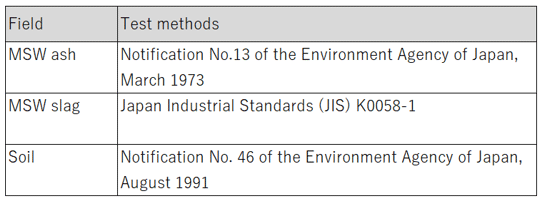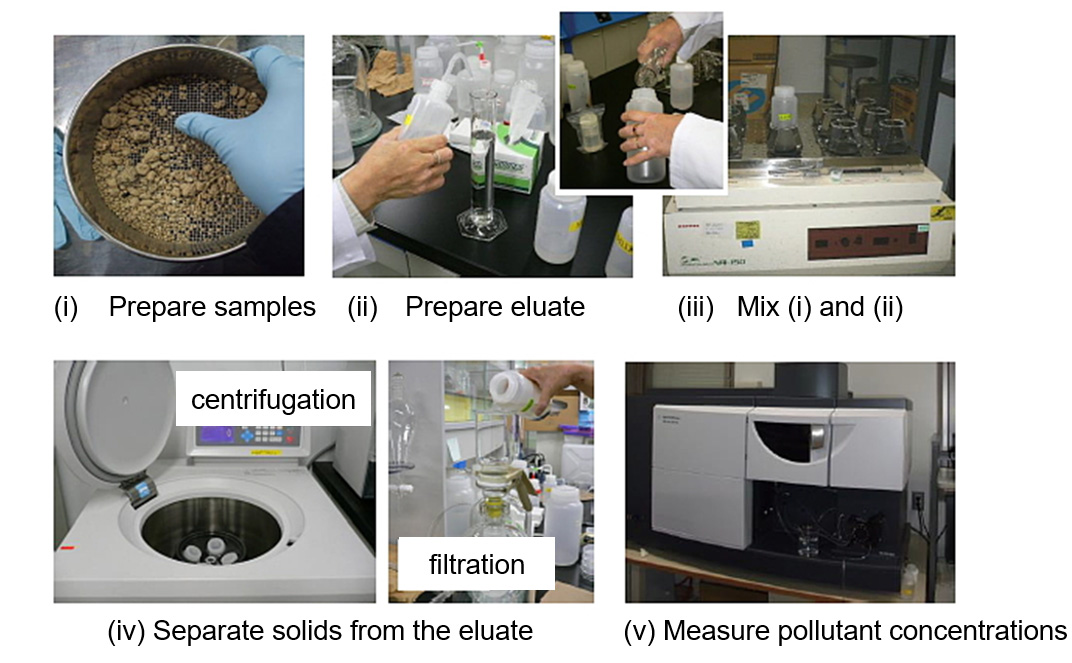- Waste management in Japan
- Circular economy in Japan
- Waste management in Asia
- Disaster waste management
Leaching Test: Roles and Future Development
Introduction
Leaching tests have been used worldwide to evaluate environmental safety of waste, by-products, and soil. For example, municipal solid waste (MSW) incineration residues are tested to judge whether they can meet the criteria of landfill. Recycled materials manufactured from by-products are evaluated whether they can be recycled into, for example, roadbed and construction materials. Soil is also investigated, and if it exceeds the limit of contamination criteria, it will be regarded as contaminated soil. Leaching tests investigate the types and extent of hazardous substances leaching out from these materials.
In Japan, leaching tests are prescribed in laws, regulations, and industrial standards covering each of these materials (see Table 1). These officially designated leaching tests are often called "compliance leaching tests."

In addition to the compliance tests, various other leaching tests have been proposed by research papers and academic societies. Like JIS, various standards for leaching tests are found worldwide. Among them are International Organization for Standardization (ISO) standards, European Standards (ENs) and German Institute for Standardization (DIN) standards. "Standardization" is the process of agreeing on and formalizing a technical standard for a certain test method in conformity with the rules of these organizations. If standardized, the test method can be referred to and applied by anyone. In other words, the standardized test can impartially evaluate different items at different locations.
Regarding the compliance leaching tests, we already released some introductory articles in the past: "Leaching Tests" in the April 16, 2007 issue and "Revision of the Testing Methods for Industrial Waste" in the April 2013 issue (both in Japanese). As a supplement to them, this article presents more detailed information on compliance leaching test requirements. Recent activities related to international standardization of "up-flow percolation test" are also introduced.
Requirements for compliance leaching tests
Compliance leaching tests should satisfy the following requirements.
(1) Similar results are obtained when following the prescribed procedure.
(2) The test method is not too complicated.
(3) The test can assess the risk of future environmental pollution at the most accurate level.
The requirement (1) may be obvious, but the point is the word "similar." The reason for using this word is because variations and errors must be permitted for any test. In general, the procedure of a leaching test is the following: (i) prepare solid samples by sieving (drying and crushing can be adopted depending on the test method); (ii) prepare water to elute hazardous substances; (iii) mix (i) and (ii) by agitation or shaking; (iv) separate solids from the eluate by centrifugation or filtration; and (v) measure the concentrations of hazardous substances in the eluate (Fig.1). It appears that many steps in this procedure are likely to affect the test results in terms of variations and errors.
You may think that making more rigorous test procedure can minimize variations and errors. However, this is not always welcomed, unfortunately. If overly strict test methods are applied, their implementation would become more complicated, time-consuming and costly. If you make a small mistake, you have to repeat the test many times. That is, if the test item does not affect the test results, more lax requirements are preferable. The requirement (2) is very important for anyone who conducts a leaching test.
Then, what about the requirement (3)? A leaching test is supposed to assess what is likely to occur in the natural environment over a long period of time. However, it instead attempts to assess the natural phenomenon quickly in a laboratory. Therefore, this requirement (3) is the most important yet difficult one among the three. Here is an example of the difficulty; past laboratory soil leaching test results suggest that shaking or agitating soil samples in a leaching test may cause soil particles to collide with each other or against the testing equipment and to become worn down. This may lead to high-value results of the leaching test. However, the deterioration of soil particles is extremely rare in the natural environment. If we use these high-value test results as a base for pollution control, we may end up spending a lot for treating the soil that does not pollute the environment. This example suggests that it is better to revise the requirements as necessary if they are found to be too specific or unbalanced.

International standardization for leaching tests
Our research team has been actively participating in ISO's discussions as part of Japan's efforts toward international standardization of chemical testing of soil including its leaching test procedures. As of June 2015 at the time of this writing, a soil leaching test procedure ISO/TS 21268-3 Up-flow Percolation Test (i.e., a test procedure that allows water to percolate upward in a column filled with soil) (see our past article in the June 2015 issue [in Japanese]) has not yet been officially approved. In order to facilitate the formalization process, a Japan-led project has started to verify the test requirements and accuracy. The following final section explains how this project was proposed, and what we aim to achieve through this project.
The existing compliance tests all use a method called "single-step batch test" where a single result is obtained in one experiment. In contrast, the percolation test enables us to capture how the concentrations of hazardous substances increase/decrease in the eluate according to different water percolation time and volume conditions. These results are thought to be closer to the state of the natural environment, if not entirely the same, than those obtained from the single-step batch tests. Thus, we expected that the up-flow percolation test could complement the existing compliance leaching tests in assessing the above-mentioned "risk of future environmental pollution."
We thought that a new JIS publication of the up-flow percolation test method would be very effective for its wider use. Regarding this point, the present international agreement obliges national industrial standards to prioritize any existing international standard (i.e., ISO standard in this case) if it is deemed equivalent to the proposed method. In the current case, fortunately, we knew the international standard of the up-flow percolation test, ISO/TS 21268-3 because we had been involved in various ISO activities related to chemical testing of soil. However, ISO/TS 21268-3 of 2007 was merely a technical specification (TS) at that time, and it had not yet been approved as a formal ISO standard.
That was why we formulated a project proposal that can contribute to the approval and formalization of the TS 21268-3 as an ISO standard with our final objective of its future adoption by JIS. The proposal was submitted for consideration to ISO's Technical Committee (TC) dealing with chemical testing of soil. It was approved in October 2014 for a duration of three years. During this period, by gaining the understanding and cooperation of many parties involved, the project team needs to achieve concrete results through various activities including a review of the test methods and accuracy. The path to formalizing the percolation tests as ISO and JIS standards may be difficult, but we will continue our efforts to attain this goal in near future.
Postscript (2021-06-15): ISO 21268-3 was published as a formal ISO standard in September 2019, and currently, JIS's standardization activity based on the ISO standard is in progress.
For more information
- Sakanakura H. (2014) Current status and topics surrounding leaching tests: official methods and trends in international standardization, Material Cycles and Waste Management Research, 25(5), 361-368
- Hirata K., Kasyu N., Kawamura K., Kunimatsu W., Sakanakura H., Study group of investigation for analysis of soil and groundwater contamination (2014) Fundamental examination of test method for analysis of soil elution, Proceedings of the 20th Symposium on Soil and Groundwater Contamination and Remediation, 148-152


